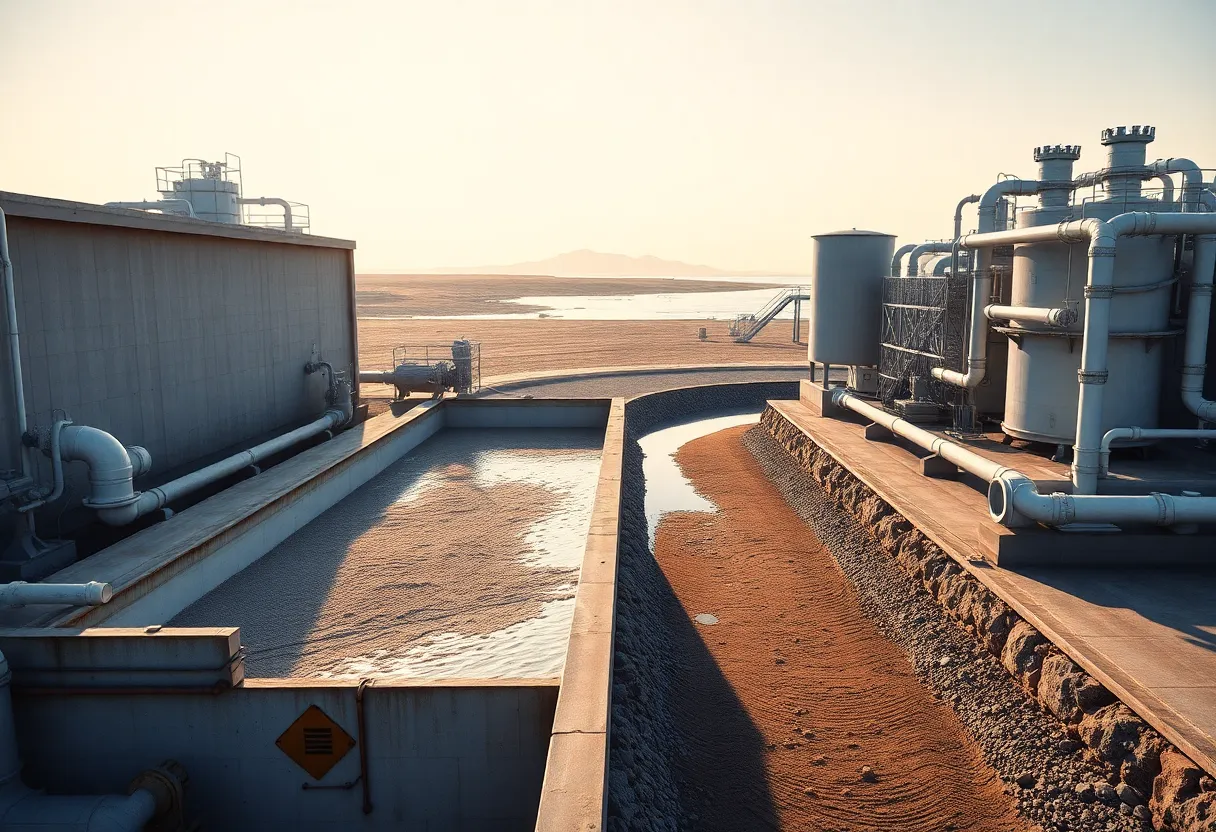Muscat, Oman, August 20, 2025
News Summary
Researchers and companies are advancing ultrasonic sea-sand desalination, a DAC-plus-desalination pilot, and a major financed desalination plant in Oman to secure materials and water for construction and industry. The ultrasonic device uses cavitation to reduce sand salt to 0.04% or lower while cutting water use compared with traditional washing. A pilot linking direct air capture with seawater desalination aims to remove about 1,000 metric tons of CO2 per year and produce fresh water. Separately, $130 million in financing was arranged for a 100,000 m³/day desalination plant west of Muscat to supply utilities and industry.
New desalination methods could ease sand shortages, cut carbon and boost water supply
Three separate developments this year point to fast change in how builders, utilities and industry manage two linked shortages: sand for concrete and clean water — and the stubborn rise of carbon emissions from heavy industry. At the top of the story is a newly tested ultrasonic sea-sand desalination device that can remove salt from sea sand with far less water than older methods. At the same time, a pilot deal has been signed to combine direct air carbon capture with seawater desalination, and a major desalination plant in the Middle East has secured project finance.
Why this matters now
River sand is in short supply in many places because of strict environmental rules and long-term overextraction. Builders are increasingly turning to sea sand as an alternative, but sea sand carries high salt levels that can corrode steel rebar inside concrete. Corroded steel weakens structures and can cause safety problems and expensive repairs. Removing that salt efficiently has been a hard engineering problem.
Ultrasonic washing cuts water use, meets safety limits
Researchers developed an ultrasonic washing device that uses sound-driven cavitation — tiny bubbles that form and collapse — to scrub salt from sand without physical contact. The process mixes sea sand with water at a ratio of one part sand to two parts water, applies ultrasonic energy at 300 watts or more for about three minutes, and produces sand with salt levels at or below the widely recommended construction limit of 0.04%. That is the maximum salt content advised by a national ministry for sea sand used in concrete.
Traditional sand washing typically needs around four tonnes of water to process one tonne of sand. The ultrasonic method is reported to cut that water use and to speed up desalination, while operating even in tight spaces and delivering precise, fast results. The results of lab validation have been published in a peer-reviewed journal. Researchers say the technique both protects steel reinforcement and could extend the life of concrete structures when properly applied.
Carbon removal meets desalination in a pilot
Separately, a startup signed a memorandum of understanding with a state water utility and a wastewater firm to build a pilot that links direct air capture (DAC) with seawater desalination. The pilot, called Project Octopus in planning documents, will use desalination brine to help make a liquid sorbent that grabs CO2 from the air. That trapped CO2 can be converted into a stable mineral form after mixing with calcium, producing a chalk-like material that stores the greenhouse gas.
The pilot aims to remove 500 tonnes of atmospheric CO2 a year and to filter another 500 tonnes from smokestacks, while also producing fresh water for heavy industry at an industrial complex that supplies a large share of the country’s petrochemicals. The proposed pilot budget is about $2–3 million, with a possible commercial-scale plant later that could cost $100–200 million and target up to 500,000 tonnes of CO2 removal per year if fully built out.
Project planners note the pilot is energy intensive and will be tied to the electricity grid, which means emissions from grid power must be considered. The pilot is framed as a way to reduce some pollution around a major industrial hub and to provide water to industry, but the scale of the pilot capture is small compared with the hub’s annual emissions.
Finance secured for a major desalination plant
In another development, a consortium raised about $130 million to build a new desalination plant in the Gulf region. About 70% of the finance is expected from an export credit agency and local financial institutions, with the remainder provided by a commercial bank. The facility, sited roughly 60 km west of the country’s capital, is due to begin operations in 2024 and will produce 100,000 cubic metres of fresh water per day. The project operator expects long-term revenue from plant operation under a multi-decade contract.
What this means for construction and industry
- Desalinated sea sand that meets the 0.04% salt threshold can be used safely in reinforced concrete and can reduce corrosion risk and lifecycle costs.
- Lower-water desalination methods could make coastal sand sources more practical in places facing river-sand shortages.
- Combining desalination with carbon capture creates opportunities to co-produce fresh water and CO2 removal, but energy demand and grid emissions remain core concerns.
- Large desalination projects backed by export finance and commercial lenders are moving forward, showing continued investment in water infrastructure.
Next steps and risks
Researchers plan to scale ultrasonic processing to handle larger volumes faster. Pilots that pair desalination with DAC must address high power use and the source of electricity. For builders and regulators, consistent testing and certified desalination methods will be essential to ensure that sea sand is safe for long-lived concrete work. Financially, projects that combine water and carbon services will need clear cost and emission accounting to avoid prolonging fossil-fuel dependence.
FAQ
Is desalinated sea sand safe for reinforced concrete?
Yes, when salt levels are reduced to recommended limits (about 0.04% or lower), sea sand can be used safely. Proper desalination limits the risk of steel corrosion and helps preserve structural life.
How much water does the ultrasonic method use compared with traditional washing?
Traditional washing can use roughly four tonnes of water per tonne of sand. The ultrasonic method mixes sand with water at a 1:2 ratio (one part sand to two parts water) and claims significantly lower net water use and faster processing.
Can desalination brine help remove CO2 from the air?
A pilot plan uses desalination brine as part of a process to produce a liquid sorbent that captures CO2. The captured CO2 can be converted to a stable mineral form, and fresh water is also produced as a byproduct. The approach is energy intensive and currently at pilot scale.
Will these projects increase fossil-fuel use?
Energy demand is a key concern. Pilots and plants tied to grids that rely on fossil fuels can increase emissions unless paired with low-carbon power. Project planning needs to include energy sources and emissions accounting.
How soon will large-scale carbon removal with desalination be available?
Pilots are underway with the aim of commercial scaling in coming years. Proposed commercial projects cite earliest groundbreaking in a couple of years, but full-scale deployment will depend on finance, energy supply, and successful pilot outcomes.
Key features at a glance
| Feature | Detail |
|---|---|
| Ultrasonic desalination | 1:2 sand-to-water mix, ≥300 W ultrasonic energy, ~3 minutes, reduces salt to ≤0.04% |
| Traditional sand washing | About 4 tonnes of water per 1 tonne of sand |
| DAC + desalination pilot | Pilot aims: 500 tCO2 from air + 500 tCO2 from smokestack annually; cost $2–3M; water as byproduct |
| Commercial DAC ambition | Potential up to 500,000 tCO2/year at full scale; major cost estimate $100–200M |
| Barka 5 desalination project | Project finance ~ $130M; 100,000 m³/day capacity; operations contract for 20 years; online in 2024 |
| Construction safety threshold | Recommended maximum salt in sand for aggregate: 0.04% |
Deeper Dive: News & Info About This Topic
Additional Resources
- Scientific Reports: Ultrasonic sand desalination study
- Wikipedia: Desalination
- The Verge: DAC + desalination pilot (South Korea)
- Google Search: DAC desalination pilot South Korea
- Global Construction Review: Oman desalination plant financing
- Google Scholar: Oman desalination plant financing
- Smart Water Magazine: LG Chem $95M water treatment investment
- Encyclopedia Britannica: LG Chem water treatment
- MEED: Acciona signs Qatar 110 MIGD desalination contract
- Google News: Acciona Qatar desalination 110 MIGD
Author: Construction CA News
The CALIFORNIA STAFF WRITER represents the experienced team at constructioncanews.com, your go-to source for actionable local news and information in California and beyond. Specializing in "news you can use," we cover essential topics like product reviews for personal and business needs, local business directories, politics, real estate trends, neighborhood insights, and state news affecting the area—with deep expertise drawn from years of dedicated reporting and strong community input, including local press releases and business updates. We deliver top reporting on high-value events such as the Rose Parade, Coachella, Comic-Con, and the California State Fair. Our coverage extends to key organizations like the California Building Industry Association and Associated General Contractors of California, plus leading businesses in technology and entertainment that power the local economy such as Apple and Alphabet. As part of the broader network, including constructionnynews.com, constructiontxnews.com, and constructionflnews.com, we provide comprehensive, credible insights into the dynamic landscape across multiple states.




